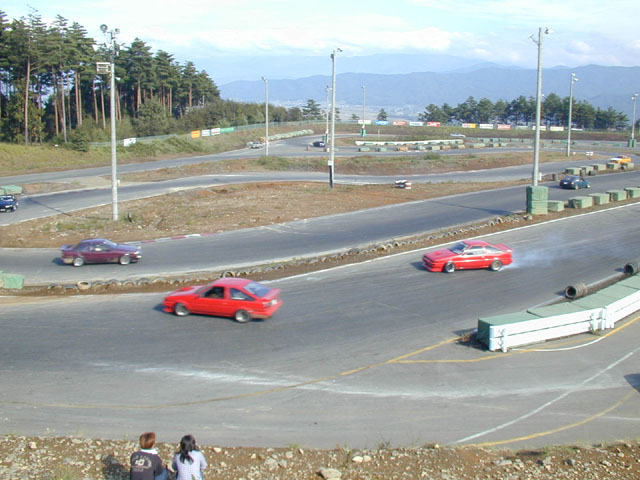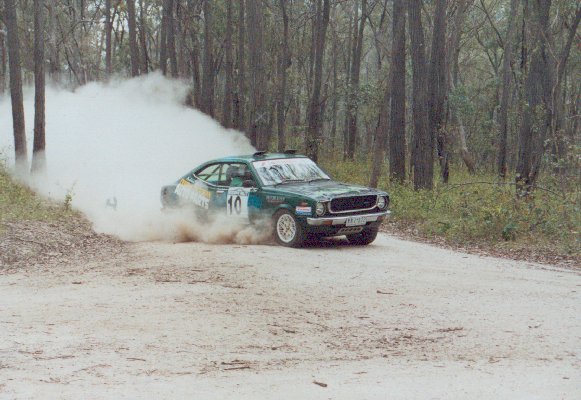
Some place in Japan.

Intro:
This is all about what happens when you finnaly get your car to the race track for some practice laps, or maybe you have driven it a bit too hard on the street and realise some driving skill could have been used to prevent a bad crash or near miss. Or, if you start practicing rally driving on a dirt road these things still apply.
FR means front engine, rear wheel drive, and is the format of the old corollas. The basic format of your car determines how it will handle when pushed to the limit. GranTorismo is a great driving simulator tool to experiment with different platforms and how they handle. The FR format is most favored as a low cost drift machine that is not too hard to drive.
Don't ever think you are a good driver if you have never felt your car drift, with front or rear wheels slipping and been confident of still maintaining control. Doing a burnout, skidding, drifting etc may be for a hooligan, but to be a good driver you need to contol the vehicle when its is slipping. For good practice, try all techniques on a low friction surface at low speed, such as a wet sealed carpark, or a gravel area.
Power over:
This is the easiest thing to do. If your car is powerfull enough (or the friction is low), just depress the throttle and the wheels will light up and step the back of the car out. It is easy to do on the exit of a corner, controled with some counter steering. Many a bogan with a Commodore (or redneck with a Mustang) will be able to do this.
Handbrake:
Called the emergency brake (or e-brake) in America, pull it hard after you have already turned the car slightly with the steering wheel, and the back or the car will slide around. 180 degrees if you want. Always hold the button in with your thumb, and don't release untill the brake is off again. Also you need to press the clutch pedal at the same time with a FR car, to stop the engine stalling. A neat trick is to have the car in low gear before using the hand brake, swing the car slightly with the steering wheel, pull the handbrake for a 180 degree turn while you step on the clutch. At the same time rev the motor, and as you have almost completed your 180, drop the clutch and power out of the turn. This makes for a neat U turn or 360 degree spin.
When you are learning, drift will mostly be initiated with the handbrake. Use the handbrake (and steering motion) to get the car loose and sideways, then drop the clutch and rev like when you do a U turn, but with more counter steer to continue to take the corner in the track. Other techniques below can be used to initiate drift (oversteer) at higher speed, but the handbrake will be something to fall back on if they don't work.
Shift lock:
This is another technique to get the back of the car loose, to induce oversteer. Often to be used at slightly higher speed than when you use the handbrake. Downshift one gear, say from 3rd to 2nd, and drop the clutch without using heal-toe. The effect will be similar to using the handbrake. Perform this on the entry of a corner.
Brakeing:
On a good car that already has the brake bias adjusted well, or maybe you just got lucky, a simple hard brake will be enough to initiate the oversteer you need. Some skill is still needed to time your brakeing actions with the steering. The same car can either oversteer or understeer in the same corner depending on how the car is steered and weight transfer is used.
Feint Motion:
I tend to call this manoover 'flip-flop', because thats sort of what the car does. If the car is oversteering in one direction (posiably the wrong direction), you can back off the throttle, jab the brakes and the car will flip around (quite violently at times) and start oversteering in the oposite direction. This can be used to good effect in a S bend of a race track, or if you find yourself out of control on the entry of a corner.
It is worth noteing, this is exactly what happens when your girlfriend crashes your car. She takes a corner too fast, and the back drifts out a bit. She freaks out and over corrects the steering to little effect (setting the car up for the next event). Then hard on the brakes and the car just flips around the other way, way out of control this time untill she finnaly hits something. With some practice you can predict the cars movements and counter steer only as needed to control the vehicle. Take your girlfriends to the race track for parctice, its a good thing!
Rally drivers use this in a more obvious way. Often called the Scandinavian flick, it is used to more predictably throw the car into a corner. On a simple corner it can be a bit of hit and miss as to wether the car will understeer or oversteer. In rally, if you can get the car to oversteer a bit the wrong way leading up to the corner, it will be alot easier to flip the car around into oversteer for the corner to be taken than just trying to initiate the oversteer from scratch.
Lift off:
This is hardly a technique. But if you go into a corner at great speed without brakeing, driving on the very limit, anything at all will upset the car to get a spin happening. In this case simply backing off the throttle will be enough to upset the rear wheels. If you are already reving the engine hard, the effect can be the same as shift lock.

*** A good DVD to buy is "Drift Bible", by Best Motoring in Japan. It features 'drift king' Keiichi Tsuchiya.